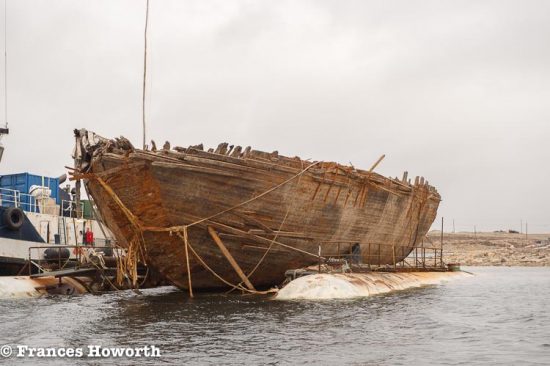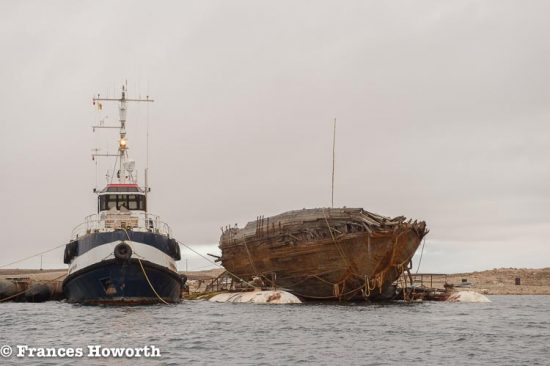
She may look a wreck but Maud is an important ship and after years of rotting in an arctic backwater is about to make her final voyage to stardom
Maud was built at a shipyard in Asker at Usiofnord, Norway for the explorer Roald Amundsen.
He was the first man to successfully navigate the Northwest Passage [1903-1905) and did so in the 47 ton sloop Gjøa.
Maud was officially christened by Amundsen 1917 who smashed a chunk of ice against the vessel’s bow and proclaimed, “You are made for ice. You shall spend your best years in ice and you shall do your work in the ice”.
She had been specifically designed to become an ice – locked scientific research ship with the idea of drifting in the polar ice pack in a bid to reach the North Pole by ship.
Built of oak the 292 ton vessel was 36.5m overall with a beam of 12.3m. Her draught was 4.85m A single semi-diesel Bolinder engine whose output was 240hp (177kW) provided her motive power.
Whereas Amundsen’s other more polar vessels Gjøa. and Fram have been preserved at the maritime museum at Bygdoy near Oslo, poor old Maud has until now been subject to a far less glamorous destiny.
The original idea had been for her to serve Amundsen on two different voyages (1918-21) and (1922-25) crossing both the Northeast Passage and much of the Northwest Passage.
In 1925 when Amundsen sailed into Nome, Alaska, he was met by creditors waiting for him on the dock. Yet again, as he had been for much of his life, he was unable to pay his bills. The ship was arrested and taken to Seattle, Washington. There she was sold to the Hudson’s Bay Company and went back into the frozen waters of the Artic to begin trading

Maud was renamed Baymaud and in 1926 and in 1927 she re-supplied Hudson’s Bay Company posts in the Western Arctic.
In July 1927 the Hudson’s Bay Company post at Kent Peninsula was dismantled and moved by Baymaud to Cambridge Bay where the new Hudson’s Bay Company post was established.
The decision was then made to leave the ship at Cambridge Bay because such a ship was not suitable for navigation in the district.
Semi abandoned Baymaud was left and was used as a floating machine shop, warehouse and wireless station.
In 1930 developed a serious leak around her propeller shaft, which could not be repaired without docking facilities. She sank at her moorings in about 7 meters (20 feet) of water.
Over the next 5 years or so, everything above the water was salvaged, with the material being used as everything from building a new HBC warehouse, to firewood.
In 1947, the RCMP blew the stern of the boat apart with dynamite so that the fuel tanks could be removed and drained while she lay just sticking out of the water along the shoreline of what is locally known as Carl’s Bay.
In the late 1920’s Baymaud was refitted in Vancouver, British Columbia in a project supervised by Tom Hallidie. It was he who later went on to design the St. Roch basing much of St Roch on the lines of Maud.
So it is fitting that this sad looking wreck is about to be towed from Cambridge Bay in Canada to a new home in Norway where she will be loved and cared for while shipwrights restore her to her former glory. Once completed she will join her equally famously preserved sisters Gjøa and Fram at the maritime museum at Bygdoy near Oslo, Norway.
Frances and Michael Howorth explored the North West Passages onboard Ocean Endeavour with the help of Destination Canada www.destinationcanada.com and Adventure Canada www.adventurecanada.com We are truly grateful to them both for the opportunity they provided with us to do our job.
